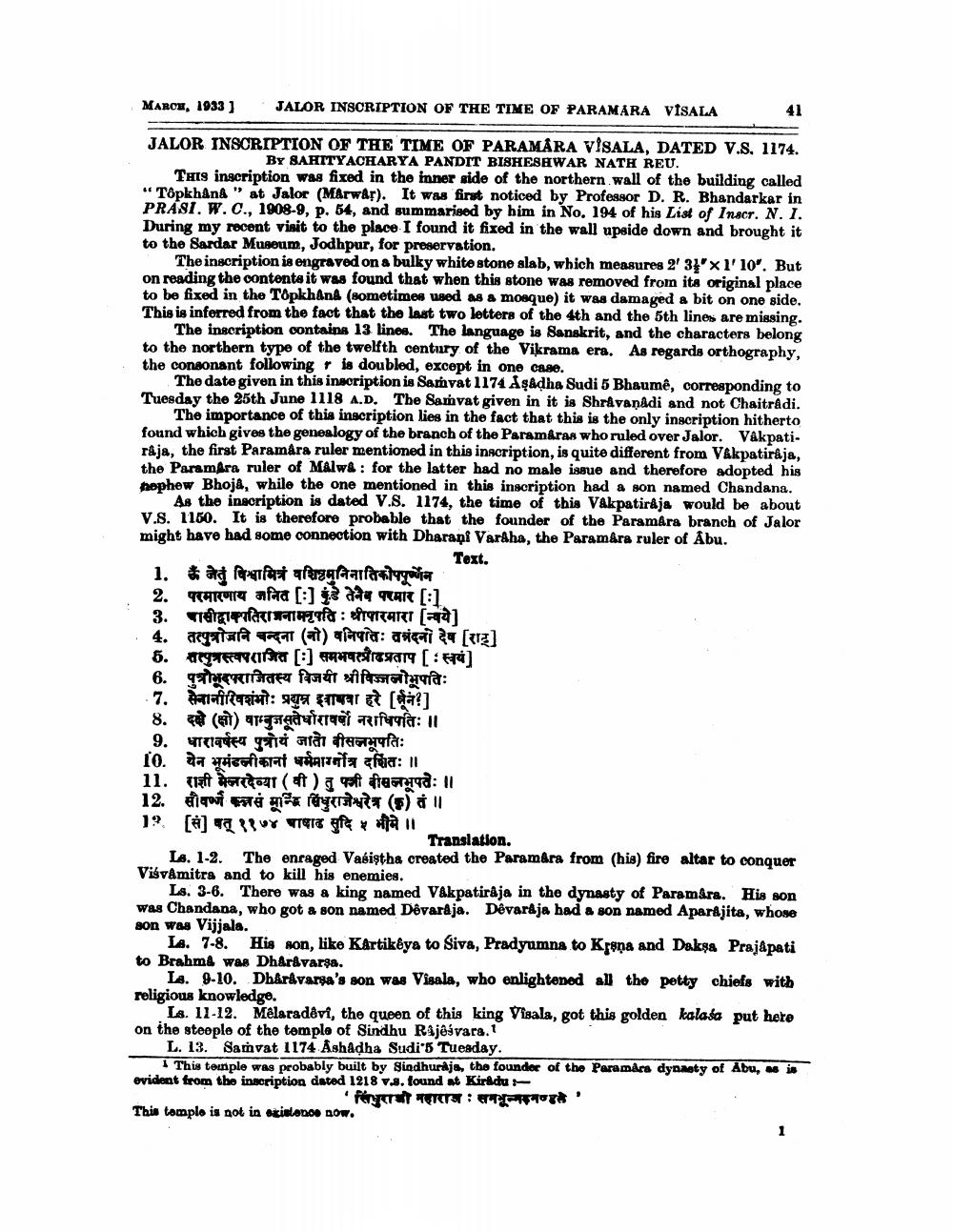________________
MAROW, 1933 )
JALOR INSCRIPTION OF THE TIME OF PARAMARA VISALA
JALOR INSCRIPTION OF THE TIME OF PARAMÅRA VISALA, DATED V.S. 1174.
BY SAHITYACHARYA PANDIT BISHESHWAR NATH REU. This inscription was fixed in the inner side of the northern wall of the building called "Topkhân " at Jalor (Marwar). It was first noticed by Professor D. R. Bhandarkar in PRASI.W.C., 1908-9, p. 54, and summarised by him in No. 194 of his List of Inscr. N. I. During my recent visit to the place I found it fixed in the wall upside down and brought it to the Sardar Museum, Jodhpur, for preservation.
The inscription is engraved on a bulky white stone slab, which measures 2' 31'xl' 10'. But on reading the contents it was found that when this stone was removed from its original place to be fixed in the TopkhAnA (sometimes used as a mosque) it was damaged a bit on one side. This is inferred from the fact that the last two letters of the 4th and the 5th lines are missing.
The inscription oontains 13 lines. The language is Sanskrit, and the characters belong to the northern type of the twelfth century of the Vikrama era. As regards orthography, the consonant following ris doubled, except in one case.
The date given in this inscription is Samvat 1174 Aşadha Sudi 5 Bhaumê, corresponding to Tuesday the 25th June 1118 A.D. The Samvat given in it is Shravanadi and not Chaitrådi.
The importance of this inscription lies in the fact that this is the only inscription hitherto found which gives the genealogy of the branch of the Paraméras who ruled over Jalor. Våkpati. rája, the first Paramâra ruler mentioned in this inscription, is quite different from V&kpatirkja, the Paramara ruler of Malw&: for the latter had no male issue and therefore adopted his hephew Bhoją, while the one mentioned in this inscription had a son named Chandana.
As the inscription is dated V.8. 1174, the time of this Vakpatirêja would be about V.S. 1150. It is therefore probable that the founder of the ParamAra branch of Jalor might have had some connection with Dharani Varaha, the Paramara ruler of Abu.
Text. 1. Peperfat alergiaalfonilegaria 2. PARURE afara [:) is the man [:1 3. Tergarafarmagala : TYTTATT (=]
तत्पुत्रोजनि चन्दना (नो) वनिपातः वनंदनी देव [राट् M ira :) Rear :)
पुत्रोभूदपराजितस्य विजयी श्रीविजनोभूपतिः 7. Salatlaria?: aya karar (ä?] 8. (a) ar autreet perfura: 11
धारावर्षस्य पुत्राय जातो बीसलभूपतिः
येन भूमंडलीकानां धर्ममार्गोत्र दर्शितः ॥ 11. decat (*) dad: 11 12. count mana lata (c) all 1?. [] PP u vrere fe l
Translation. LA. 1-2. The enraged Vabistha created the Paramara from (his) fire altar to conquer Visvamitra and to kill his enemies.
Ls. 3-6. There was a king named Vakpatiraja in the dynasty of Paramara. His son was Chandana, who got a son named Devaraja. Dêvarêja had a son named Aparajita, whose son was Vijjala.
Ls. 7-8. His son, like Kartikeya to Siva, Pradyumna to Krsna and Daksa Prajapati to Brahmê was Dhårdvarsa.
LA. 9-10. Dhåråvarsa's son was Visala, who enlightened all the petty chiefs with religious knowledge.
Ls. 11-12. Melaradêvî, the queen of this king Visala, got this golden kalasa put here on the steeple of the temple of Sindhu Rajêsvara.1
L. 13. Samvat 1174 Ash&dha Sudi 6 Tuesday.
This temple was probably built by Sindhurajs, the founder of the Paramáca dynasty of Abu, as in ovident from the inscription dated 1218 v.3. found at Kiradu
fra TIC: T op! This tampla is not in scislands now.
Los




